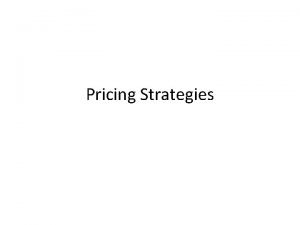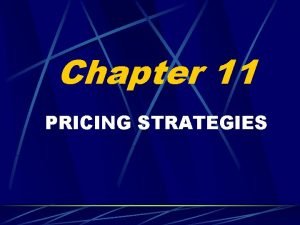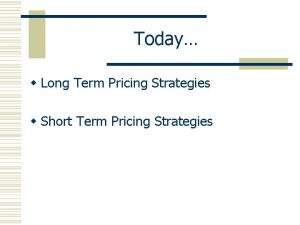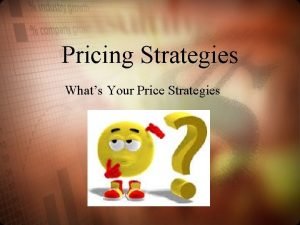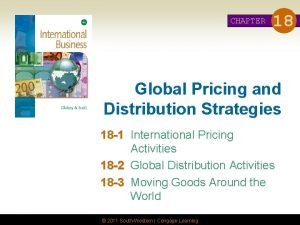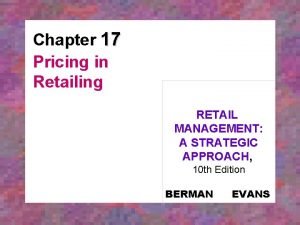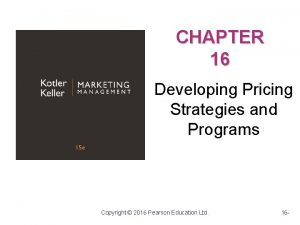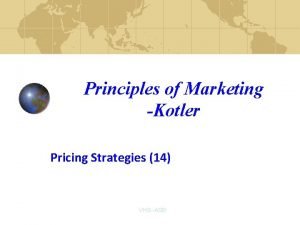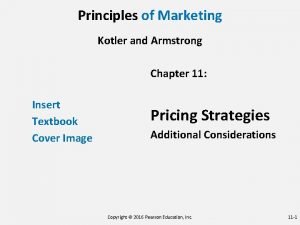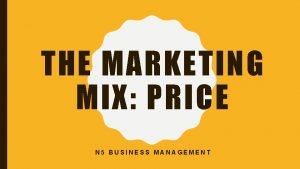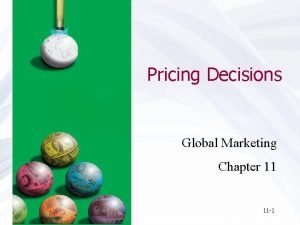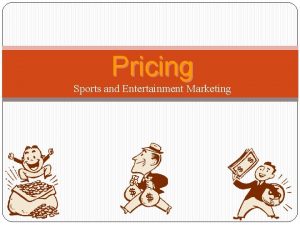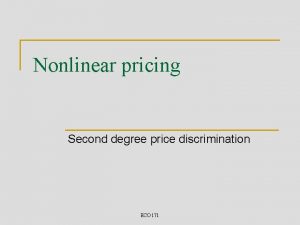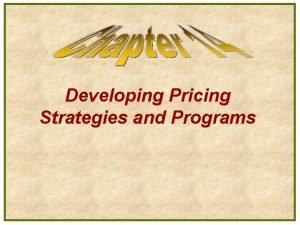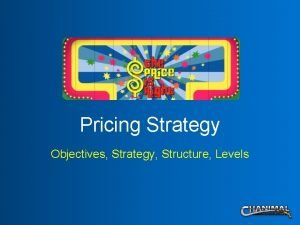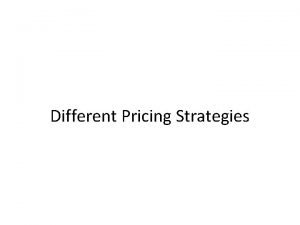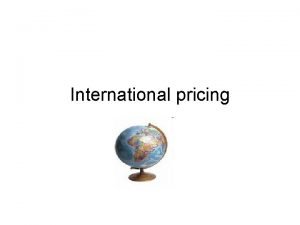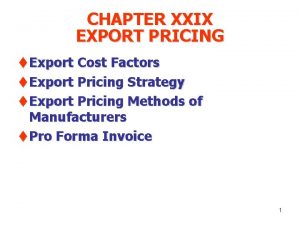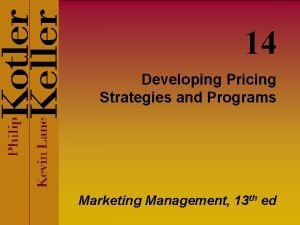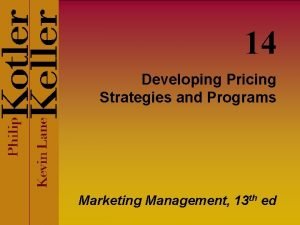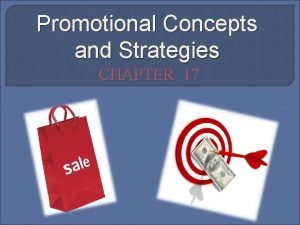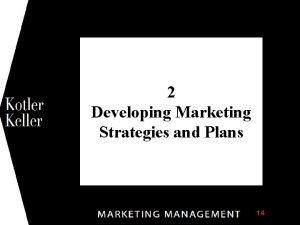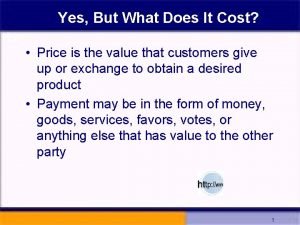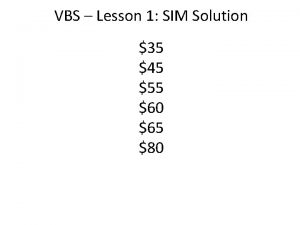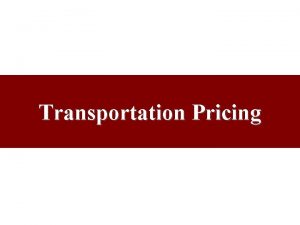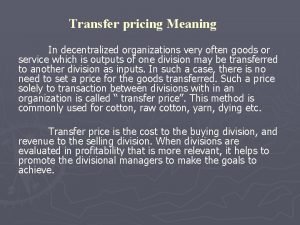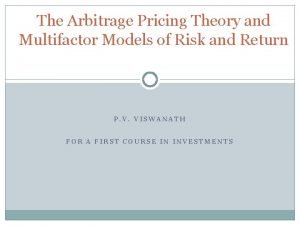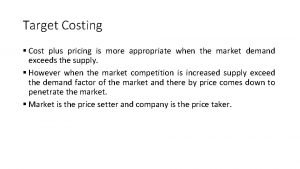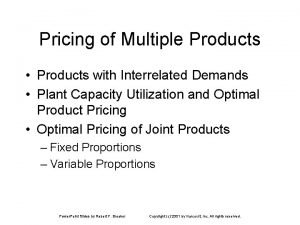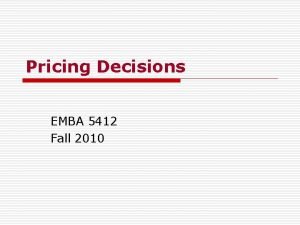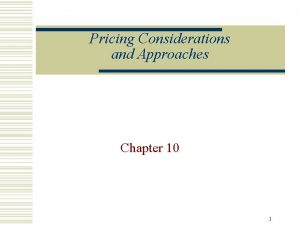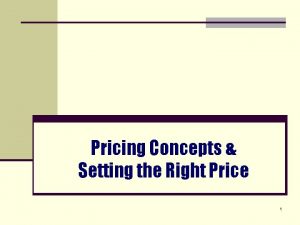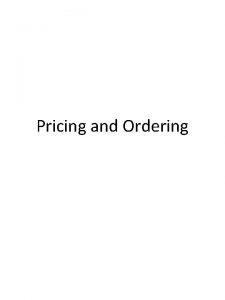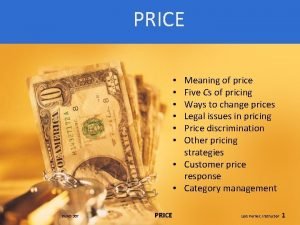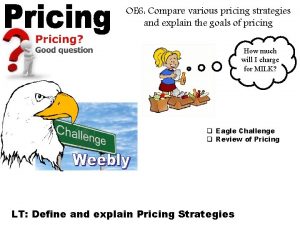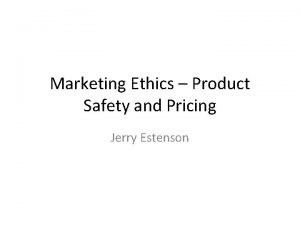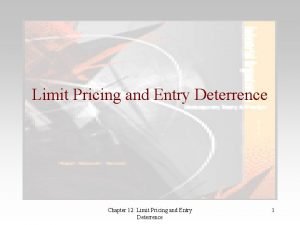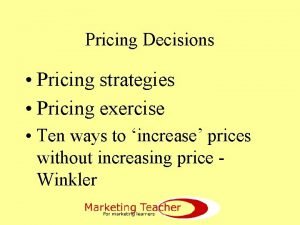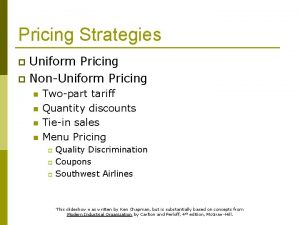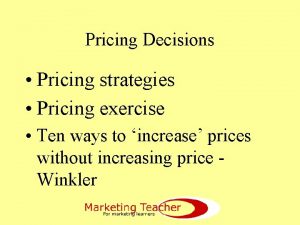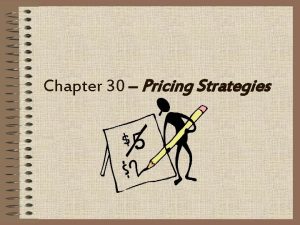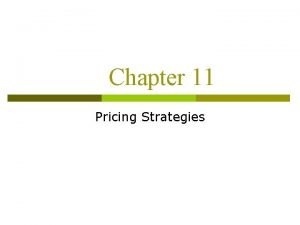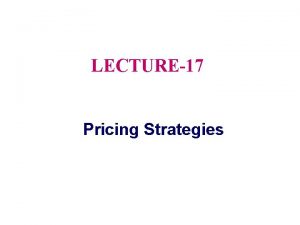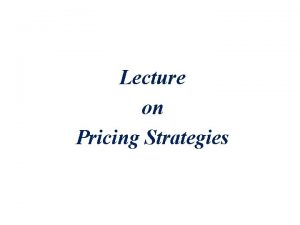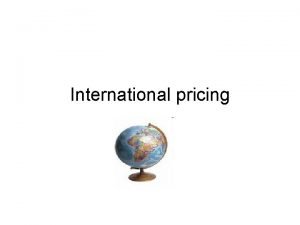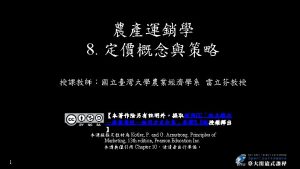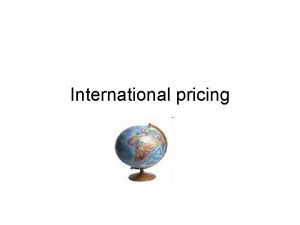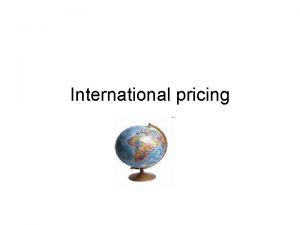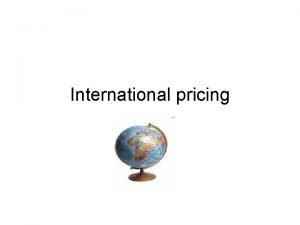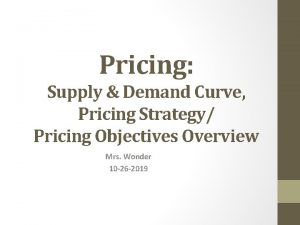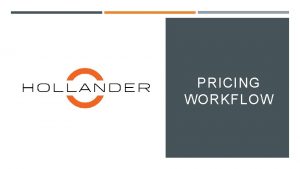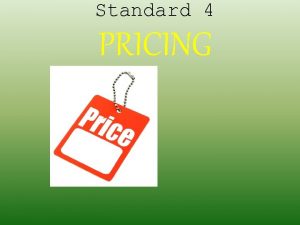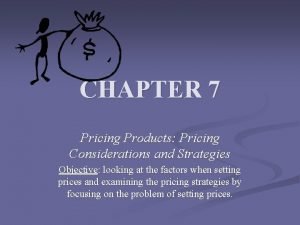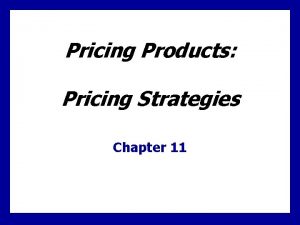Chapter 11 PRICING STRATEGIES Chapter 11 Pricing Strategies




































































- Slides: 68

Chapter 11 PRICING STRATEGIES

Chapter 11 Pricing Strategies In this chapter, we focus on 3 parts: 1 The process of price setting 2 Pricing strategies 3 Initiating and Responding to Price Change

Chapter 11 Pricing Strategies 1 The process of setting price Former process Designing a new product Determining its cost Asking ‘can we sell it for this’ Now An ideal selling price based on customer considerations Targets costs that will ensure that the price is met

Chapter 11 Pricing Strategies 1 The process of setting price Selecting the Pricing Objective Selecting the Final Price Determining Demand Selecting Pricing Method Estimating Costs Analyzing Competitors’ Costs, prices, and Offers

Chapter 11 Pricing Strategies 1. 1 Selecting the Pricing Objective 1. 1. 1 The position of the product 1. 1. 2 the Pricing Objective

Chapter 11 Pricing Strategies 1. 1. 1 The position of the product Under the circumstances, companies must firstly decide on target price for a product, then decide on its target cost and other marketing mix. Before selecting the pricing objectives, the firm must decide where to position its product on quality and price.

Chapter 11 Pricing Strategies 1. 1. 1 The position of the product Segment ( 市场细分) Example Ultimate ( 最高) Mercedes-Benz vs. Rolls Royce Luxury ( 豪华 ) Audi Special Need ( 特别需要 ) Volvo Middle ( 中档 ) Buick vs. Toyota Convenience ( 便利 ) Escort vs. Lexus Me too, but cheaper ( 类似品,但较便宜 ) Hyundai Price Alone ( 价格导向 ) Daihatsu For example if GM decides to produce a new sports car to compete with European sports cars in the higher-income segment, suggests charging a high price.

Chapter 11 Pricing Strategies 1. 1. 2 the Pricing Objective Survival Maximum Current Profit Maximum Current Revenue Maximum Sales Growth Maximum Market Skimming Market share leadership Product-Quality Leadership Competition Restraining price stabilization …

Chapter 11 Pricing Strategies 1. 2 Determining Demand 价 $15 格 $15 价 格 $10 100 105 每期的需求数量 50 150 每期的需求数量

Chapter 11 Pricing Strategies 1. 2. 1 Demand curve ●a curve that shows the number of units the market will buy in a given time period at different prices that might be charged.

Chapter 11 Pricing Strategies 1. 2. 2 the price-demand relationship ● the demand usually increases when price falls. price The balance point supplies demands Quantity sold But the rule is probably broken in some circumstances.

Chapter 11 Pricing Strategies 1. 2. 3 Factors Affecting Demand. Price Sensitivity Unique-Value Effect Substitute-Awareness Effect Difficult-Comparison Effect Total-Expenditure Effect End-Benefit Effect Shared-Cost Effect Sunk-Investment Effect Price-Quality Effect Inventory Effect

Chapter 11 Pricing Strategies 1. 2. 4 Price elasticity ●Price elasticity: a measure of the sensitivity of demand to changes in price. It is described as follows: Price elasticity of demand =(% change in quantity demand) / (% change in price) or as follows:

Chapter 11 Pricing Strategies 1. 2. 4 Price elasticity Discussion of price elasticity: ∞ × (1,∞)(elastic) E = 1 × (0,1)(inelastic) 0 × For elastic: ↓P → Q↑↑ → PQ ↑ → profit ↑ For inelastic: ↑↑ P → Q ↓ → PQ ↑ → profit↑

Chapter 11 Pricing Strategies 1. 3 Estimating Costs 1. 3. 1 Type of costs 1. 3. 2 Cost Behavior 1. 3. 3 The Experience Curve 1. 3. 4 Cost , variety and quality 1. 3. 5 Pricing according to Cost

Chapter 11 Pricing Strategies 1. 3. 1 Type of costs ●variable costs: costs that vary directly with the level of production. ●fixed costs: costs that do not vary with production or sale level. ●total costs: the sum of the fixed and variable costs for any given level of production. ●marginal costs: increased cost produce a unit of product. ●average costs: total costs/quantity produced = variable costs+ fixed costs /quantity produced

Chapter 11 Pricing Strategies 1. 3. 2 Cost Behavior 短期平均 成本曲线 单 位 成 本 1 2 3 4 短期平均 成本曲线 长期平均 成本曲线 1,000 1, 000 2, 000 3, 000 4, 000 每天生产的数量 Cost Behavior in a Fixed. Size Plant Cost Behavior Over Different-Size Plants (在固定规模 厂中的成本特性) (不同规模 厂的成本特性)

Chapter 11 Pricing Strategies 1. 3. 3 The Experience Curve (经验曲线) $10 单 $8 位 成 $6 本 · A 当前价格 · B · C 经验成本曲线 $4 $2 100, 000 200, 000 400, 000 800, 000 Accumulated Production 积累生产

Chapter 11 Pricing Strategies 1. 3. 4 Cost , variety and quality ◆成本与品种 C 总质量成本 C O ◆成本与质量水平 n O 质量 预防 质量故障 Quality Level

Chapter 11 Pricing Strategies 1. 3. 5 Pricing according to Cost Discussion: How pricing according to costs? ●if price≥average cost, then profits≥ 0. ●if price<average cost, then profits< 0. Under some specific circumstances, it can be allowed, but price can't be lower than variable cost, so variable cost is usually considered the floor price. ●if price<marginal cost, doesn’t mean lack of profit for a company thought negative profit per unit of product, because price might be higher than average cost, unless sold quantity excess a limited quantity.

Chapter 11 Pricing Strategies 1. 3. 5 Pricing according to Cost Discussion: How pricing according to costs? Price, cost, $ Demand Marginal cost Average cost Max Profit Min Cost Quantity produced

Chapter 11 Pricing Strategies 1. 4 Analyzing Competitors’ Costs, prices, and Offers Competitors’ costs, prices, and offers ●The company’s pricing strategy may affect the nature of the competition it faces. For example, If Canon follows a high-price, highmargin strategy, it may attract competition. A low-price, low-margin strategy, however, may stop competitors or drive them out of the market.

Chapter 11 Pricing Strategies 1. 4 Analyzing Competitors’ Costs, prices, and Offers ●The company’s pricing strategy may affect the nature of the competition it faces. For example, If Canon follows a high-price, high-margin strategy, it may attract competition. A low-price, lowmargin strategy, however, may stop competitors or drive them out of the market.

Chapter 11 Pricing Strategies 1. 4 Analyzing Competitors’ Costs, prices, and Offers different types of markets: ●Pure competition: priced by market ●Monopolistic competition: mainly priced by market competition, a trade arrangement is probably reached by sellers, but its binding force is feeble. ●Oligopolies competition (寡头竞争): priced by sellers’ arrangement ●Pure monopoly(独占): priced by a seller

Chapter 11 Pricing Strategies 1. 5 Selecting Pricing Method Markup Pricing Target-Return Pricing Perceived-Value Pricing Going-Rate Pricing Sealed-Bid Pricing

Chapter 11 Pricing Strategies Pricing theories and approaches Product costs Price floor No profits below this price Competitors’ price other internal and external factors Consumer Perceptions of value Price ceiling No demand above this price

Chapter 11 Pricing Strategies 1. 5 Selecting Pricing Method ● 1. 5. 1 Cost-based pricing ● 1. 5. 2 Break-even analysis and target profit pricing ● 1. 5. 3 Value-based pricing ● 1. 5. 4 Competition-based pricing ● 1. 5. 5 Advantages and disadvantages of each pricing approach

Chapter 11 Pricing Strategies 1. 5. 1 Cost-based pricing ●(1) Definition: adding a standard markup to the cost of the product. ●(2) Formation: ■product price= unit cost + markup price, ■unit cost= variable cost + fixed costs / sales volume, ■markup price= unit cost × added rate, or=unit cost /(1 -desired return on sales)

Chapter 11 Pricing Strategies 1. 5. 2 Break-even analysis and target profit pricing ●(1) Definition: setting price to break even on the costs of making and marketing a product; or setting price to make a target profit. ●(2) Formation: ■ product price=unit variable cost+ (target profit +fixed cost)/ sales volume

Chapter 11 Pricing Strategies (3) Relation among sales volume, costs and profits Formation: profit=(price-variable cost) × production/sale volume-total fixed cost Income/profit/price Total income Break even price Total cost Fixed cost break-even volume Sales volume break-even volume = fixed cost / (price – variable cost)

Chapter 11 Pricing Strategies (3) Relation among sales volume, costs and profits R=(P-Cv)×Q-Co R 、Co分为统计期的利润、固定成本 Q为统计期的产销量 Cv为单位产品的可变成本 ●pricing based on target profits

Chapter 11 Pricing Strategies 1. 5. 3 Value-based pricing ●(1) Definition: setting price based on buyers’ perceptions of value rather than on the seller’s cost. ●(2) Value pricing: offering just the right combination of quality and good service at a fair price.

Chapter 11 Pricing Strategies 1. 5. 3 Value-based pricing ●(3) The proceeding of value-based pricing Cv Co 1 价格 P 1 销售量 Q 1 2 P 2 Q 2 R 2 … … k … n Pk … Pn Qk … Qn Cv Co 利润 R 1 Max Rk … Rn Pricing: P = Pk Max{R 1,R 2,…,Rk,…,Rn}

Chapter 11 Pricing Strategies 1. 5. 3 Value-based pricing ●(3) The proceeding of value-based pricing Cost-based pricing product customers cost price value Value-based pricing Customers product value price cost

Chapter 11 Pricing Strategies 1. 5. 4 Competition-based pricing (1) Definition: setting prices based on the prices that competitors charge for similar products. (2)Forms: ● going-rate pricing ● sealed-bid pricing


Chapter 11 Pricing Strategies 1. 5. 5 Advantages and disadvantages of each pricing approach (2) value-based pricing on the contrary with cost-based pricing


Chapter 11 Pricing Strategies 1. 6 Selecting the Final Price Psychological Pricing The Influence of Other marketing. Mix Elements on Price Company Pricing Policies Impact of Price on Other parties

Chapter 11 Pricing Strategies 2. 1 New-product Pricing Strategies 2. 2 Price-adjustment Strategies

Chapter 11 Pricing Strategies 2. 1 New-product Pricing Strategies Pricing strategies usually change as the product passes through its life cycle. The introductory stage is especially challenging. Companies bringing out a new product face the challenge of setting prices for the first time. They can choose their strategies: ● market-skimming pricing ● market-penetration pricing

Chapter 11 Pricing Strategies 2. 1. 1 market-skimming pricing ●Definition: setting a high price for a new product to skim maximum revenues layer by layer from the segments willing to pay the high price. ●Applied conditions of market skimming: firstly, the product’ quality and image must support its higher price, and there are enough buyers at the level of higher price. secondly, the costs of producing a smaller volume cannot be so high that they counteract the advantage of higher price. finally, competitors should not be able to enter the market easily and undercut the high price.

Chapter 11 Pricing Strategies 2. 1. 2 Market-penetration pricing ●Definition: setting a low price for a new product in order to attract a large number of buyers and a large market share. ● Applied conditions of market-penetration: firstly, the market must be highly price sensitive so that a low price results in more selling growth. secondly, production and distribution costs must fall as sales volume increases. finally, the low price must help keep out the competition, and penetration price must maintain its low-price position. Otherwise, the price advantage may be only temporary.

Chapter 11 Pricing Strategies 2. 2 Price-adaptation Strategies A company’s pricing decisions are affected by both internal company factors and external environmental factors. Besides cost and demand, other external factors, such as economic situations, policies, laws and regulations as well as social concerns also influence price a lot. In setting prices, a company’s short-term sales, market share, and profit goals may have to be tempered(调节) by broadly societal considerations.

Chapter 11 Pricing Strategies 2. 2 Price- adaptation Strategies Companies usually adjust their basic prices to account for various customer differences and changing situations.

Chapter 11 Pricing Strategies 2. 2 Price- adaptation Strategies 2. 2. 1 Geographical Pricing (地理定价) 2. 2. 2 Price Discounts and Allowance ( 价格折扣和折让 ) 2. 2. 3 Promotional Pricing (促销定价) 2. 2. 4 Discriminatory Pricing (差别定价) 2. 2. 5 Product-Mix Pricing (产品组合定价 )

Chapter 11 Pricing Strategies 2. 2. 1 Geographical pricing:Adjusting prices to account for the geographic location of customers. Its forms are as follows: ● FOB-origin pricing(free on board) ● uniform-delivered pricing (统一价) ● zone pricing ● basing-point pricing ● freight-absorption pricing(含运费)

Chapter 11 Pricing Strategies 2. 2. 1 Geographical pricing International pricing: Adjusting prices for international markets. The price that a company should charge in a specific country depends on many factors, including economic conditions, laws and regulations, and development of the wholesaling and retailing system. Consumer perceptions and preferences(感觉与偏好) also may vary from country to country, calling for different prices.

Chapter 11 Pricing Strategies 2. 2. 2 Discount and allowance pricing: Most companies adjust their basic price to reward customers for certain responses, such as early payment of bills, volume purchases, and off-season buying. Its forms are as follow: ● cash discount ● quantity discount ● functional discount ● seasonal discount ● allowances

Chapter 11 Pricing Strategies 2. 2. 3 Promotional Pricing Promotional pricing: Temporarily reducing prices, sometimes even below cost, to increase short-run sales. Its forms are as follows: ● discounts ● special-event pricing ● cash rebates ● low-interest financing ● longer warranties ● free maintenance Attention: used too frequently and copied by competitors, price promotions can create “deal-prone” customers who wait until brands go on sale before buying them. Or, constantly reduced prices can erode(腐蚀) a brand’s value in the eyes of customers.

Chapter 11 Pricing Strategies 2. 2. 3 Promotional Pricing Loss-Leader Pricing Special-Event Pricing Cash Rebates Low-Interest Financing Long-Term Payment Warranties and Service Contracts Psychological Discounting

Chapter 11 Pricing Strategies 2. 2. 3 Promotional Pricing Psychological pricing: Adjusting prices according to psychological effect. For example, one study of the relationship between price and quality perceptions of cars found that consumers perceive higher-priced cars as having higher quality. Another aspect of psychological pricing is reference prices---prices that buyers carry in their minds and refer to when looking at a given product.

Chapter 11 Pricing Strategies 2. 2. 4 Discriminatory Pricing Segmented pricing: selling a product or service at two or more prices, where the difference in prices is not based on difference in costs. Adjusting prices to allow for differences in customers, products, or locations. Its Forms are as follow: ● customer-segment pricing ● location pricing ● product-form pricing ● time pricing certain conditions must exist for segmented pricing. 1 the market must be segment able, 2 the segments must show different degree of demand

Chapter 11 Pricing Strategies 2. 2. 4 Discriminatory Pricing Customer-Segment Pricing (公司顾 客细分定价) Product-Form Pricing (产品式样定价) Image Pricing (形象定价) Location Pricing (地点定价) Time Pricing (时间定价)

Chapter 11 Pricing Strategies 2. 2. 5 Product-Mix Pricing Product-Line Pricing (产品线定价法) Optional-Feature Pricing (选择特色定价 法) Captive-Product Pricing (附带产品定价 法) Byproduct Pricing (副产品定价法) Product-Bundling Pricing (捆绑定价法)

Chapter 11 Pricing Strategies 2. 2. 5. 1 product line pricing ●Define: Setting price steps between product line items. ●Strategies: a price system of product line items doesn't't break the balance of buyer’ imagine about product grades, customer evaluations of different features, and competitors’ prices.

Chapter 11 Pricing Strategies 2. 2. 5. 2 Optional- Feature pricing ●Define: Pricing optional or accessory products sold with the main product. ●Strategies: the prices of optional or accessory products of are usually higher than their main product. Product bundle pricing ●Define Pricing bundles of products sold together ●Strategies: combining several products and offering the bundle at a reduced price.

Chapter 11 Pricing Strategies 2. 2. 5. 3 Captive-product pricing ●setting a price for products that must be used along with a main product, such as blades for a razor and film for a camera. By-product pricing ●setting a price for by-products in order to make the main products’ price more competitive.

Chapter 11 Pricing Strategies 3 Initiating and Responding to Price Change 3. 1 Initiating Price Cuts 3. 2 Initiating Price increases 3. 3 Responding to Competitor´s Price Changes 3. 4 Common method of price adjustment 3. 5 Questions considered before responding to a price change

Chapter 11 Pricing Strategies 3. 1 Initiating Price Cuts (1)Several circumstances might lead a firm to cut its price. • Excess plant capacity • Declining market share • Dominate the market through lower cost • In a period of economic recession

Chapter 11 Pricing Strategies 3. 1 Initiating Price Cuts (2)Risks of initiating price cut low-Quality Trap Fragile-Market-Trap Shallow-Pockets Trap

Chapter 11 Pricing Strategies 3. 2 Initiating Price increases (1)Reason Cost Inflation Overdemand Competition declined

Chapter 11 Pricing Strategies 3. 2 Initiating Price Increases (2)Reaction to Price Change Customers´ Reaction to Price Changes 持币待购、认知 Competitors´ Reaction to Price Changes 惯例与当前利益

Chapter 11 Pricing Strategies 3. 3 Responding to Competitor´s Price Changes Homogeneous-Product Market Nonhomogeneous-Product Market

Chapter 11 Pricing Strategies 3. 3 Responding to Competitor´s Price Changes Several options: Maintain Price Raise Perceived Quality Reduce Price Increase Price and Improve Quality Launch Low-Priced Fighter Line

Chapter 11 Pricing Strategies 3. 4 Common method of price adjustment Adoption of Delayed Quotation Pricing Use of Escalator Clauses Unbundling of Goods and Services Reduction of Discounts

Chapter 11 Pricing Strategies 3. 5 Questions considered before responding to a price change Why did the competitor raise a price change Does the competitor plan to make the price change temporary or permanent? What will happen to the company’s market share and profit if it does not respond? What are the competitor’s and other firms’ responses likely to be to each possible reaction.

 Chapter 26 pricing strategies answer key
Chapter 26 pricing strategies answer key Price adaptation strategies
Price adaptation strategies Chapter 26 pricing strategies
Chapter 26 pricing strategies Short term pricing strategies
Short term pricing strategies Multi unit pricing
Multi unit pricing Differential pricing strategy
Differential pricing strategy Pricing and distribution strategies
Pricing and distribution strategies Pricing strategies in retail management
Pricing strategies in retail management Target rate of return pricing
Target rate of return pricing Price management module
Price management module Kotler pricing strategies
Kotler pricing strategies Armstrong chapter 11
Armstrong chapter 11 Higher business pricing strategies
Higher business pricing strategies Global pricing objectives and strategies
Global pricing objectives and strategies Managing and pricing deposit services
Managing and pricing deposit services 4 ps of starbucks
4 ps of starbucks Entertainment pricing strategies
Entertainment pricing strategies 171
171 Segmented pricing
Segmented pricing Rate fences services marketing
Rate fences services marketing Pricing strategies in marketing
Pricing strategies in marketing Pricing strategies definition
Pricing strategies definition Contribution pricing strategy
Contribution pricing strategy International pricing strategies
International pricing strategies Export pricing methods
Export pricing methods Developing pricing strategies and programs
Developing pricing strategies and programs Developing pricing strategies and programs
Developing pricing strategies and programs Chapter 27 pricing math
Chapter 27 pricing math Chapter 17 promotional concepts and strategies
Chapter 17 promotional concepts and strategies Best cost provider strategy
Best cost provider strategy Developing marketing strategies and plans chapter 2
Developing marketing strategies and plans chapter 2 Contrast trade promotions and consumer sales promotions
Contrast trade promotions and consumer sales promotions Hedge ratio formula
Hedge ratio formula The marketing plan the central instrument
The marketing plan the central instrument Yes of cost
Yes of cost Knowledge matters sim answers
Knowledge matters sim answers Ltl blanket pricing
Ltl blanket pricing Transfer price meaning
Transfer price meaning Transfer pricing example
Transfer pricing example What is the nature of price
What is the nature of price The joint pricing
The joint pricing Arbitrage pricing theory model
Arbitrage pricing theory model Tesla objectives
Tesla objectives Tele
Tele Cost plus vs target costing
Cost plus vs target costing Sphereshield pricing
Sphereshield pricing System center pricing
System center pricing Startool ioo
Startool ioo Biztalk360 pricing
Biztalk360 pricing Balabit pricing
Balabit pricing Price matching
Price matching Penetration testing pricing strategy
Penetration testing pricing strategy Vieshow ticket price
Vieshow ticket price Captive-product pricing
Captive-product pricing Multiple product pricing can be for
Multiple product pricing can be for Transfer pricing examples
Transfer pricing examples General pricing approaches
General pricing approaches Predatory pricing meaning
Predatory pricing meaning Pricing business loans
Pricing business loans Floral pricing worksheet answer key
Floral pricing worksheet answer key Menu pricing methods
Menu pricing methods Cost based pricing strategy
Cost based pricing strategy The 5 cs of pricing
The 5 cs of pricing Pentagon 2000sql pricing
Pentagon 2000sql pricing Pricing strategy conclusion
Pricing strategy conclusion Multi unit pricing
Multi unit pricing Dynamics 365 tiered pricing
Dynamics 365 tiered pricing Product safety and pricing
Product safety and pricing Entry deterring price
Entry deterring price
